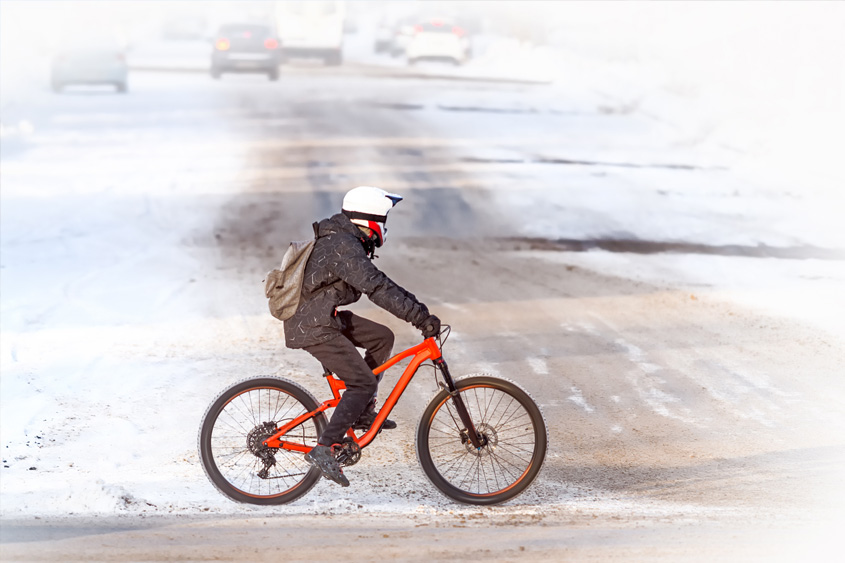 As much as we all love to ride, we know that it can be rough out there. Cyclists deal with road hazards like potholes and cracks, automobiles and buses, and we share our multi-use paths with many users: pedestrians, skateboarders, runners, rollerbladers, and even other bicyclists moving at speeds different from ours.
As much as we all love to ride, we know that it can be rough out there. Cyclists deal with road hazards like potholes and cracks, automobiles and buses, and we share our multi-use paths with many users: pedestrians, skateboarders, runners, rollerbladers, and even other bicyclists moving at speeds different from ours.
Part of being a safe cyclist is looking out for how things can go wrong, and being proactive, for yourself and for other users of our roads and paths.
Defensive biking is a must.
Watch all the traffic.
It’s critical to be aware of what is going on around you at all times. Always assume that the other person cannot see you. It’s best to stay out of blind spots – remember if you can’t see the driver’s mirrors, they can’t see you either.
Look ahead and think ahead. Watch for hazards such as potholes, gravel, construction, grates, and train tracks. Give yourself time to react to, and maneuver through or around such obstacles. Avoid swerving into traffic at all costs. Practice your quick jump-off stop. And we recommend wearing a helmet, because head injuries hurt and can leave you with long-lasting damage.
Be aware of the parked cars
Some of the worst injuries can occur when you’re just riding along next to a line of parallel-parked cars, and someone suddenly opens their car door directly into your path. “Dooring” is far too common. Avoid it by being aware of situations that could indicate a door that is about to open.
- Look for drivers inside the car.
- Look for passengers on your side of the vehicle.
- When you are approaching an area with parallel parking, reduce your speed.
- If you are confronted with an opened door, remember that it is safer to brake aggressively, rather than swerving into traffic to avoid the door.
Keep moving with the flow
The safest way to proceed is with the flow of traffic. This means that you should follow traffic signals, street signs, and other traffic control devices just as a car would. Use signals whenever possible to indicate your turns – even if you don’t think there is a car behind you.
Light Up the Night: Keep up with your safety gear
Helmets are the most important part of your cycling gear. Don’t neglect yours. If you’ve been in an accident, or if your helmet is showing signs of wear – replace it immediately. In addition, helmets need to be replaced every 3 years. They may look just fine on the exterior, but the internal components may start to break down, especially in our Colorado sunshine. Don’t risk it- keep up with your helmet’s age, and throw away your old one.
Remember your own visibility. Light clothing is the most visible, especially in the dusk or dark. The City requires a headlamp and rear flasher after dusk. Come into the shop and we can help light you up. LEDS are bright and easy to wear. Being visible and well-iluminated, even during the day, helps motorists see and avoid you. It’s why car insurance companies give discounts for vehicles with daytime running lights, and why motorcyclists always drive with their lights on.
Take off the headphones
It’s tempting, but don’t put yourself at risk by using your headphones or earbuds while you’re biking. You need to be able to hear everything around you – screeching tires, horns, or any other auditory clues about your surroundings and the adjacent traffic.
Keep steady
Both hands on the handlebars, no texting, no extra person on your bike. If you are carrying extra items – which is likely – make sure that they are contained in a backpack, trailer, pannier, fastened securely to the back of the bike. Minimize your risk of losing your balance.
Check yourself for stray strings and loose clothing. One loose shoestring in your chain and you could go straight down. The same goes for dangling straps, dangling pants hems, or other loose items you’re carrying.
Know what to do if you’re in a crash
Call the police first. No matter how small the crash is, we encourage you to make a report. When the City identifies problematic intersections or roads, they can take action to correct it, for you, next time, and for your fellow riders. If there are insurance or medical issues, that police report is an essential document for the process. Dial *CSP to report a dangerous driver. Then, much like a car accident, you’ll need to get information from the car driver. This includes their insurance information, drivers license info, car tag info, and contact information.
Make sure you talk to any witnesses, get their contact information, and take lots of notes and photos. Document road conditions, signage, and any damage to your bike or possessions. If you are encouraged to seek medical attention, make sure that you get copies of any medical records and bills.
If you are dealing with the driver’s insurance company, it’s advisable to talk to an attorney who specializes in personal injury claims. They are experienced with navigating the ins and outs of the claims process, and can be invaluable if there are problems with the process.
Stay safe, enjoy the ride, and be a smart, defensive cyclist.
PS – Tell us your safety tip in the comment section below.
Author’s Bio:
Scott Distasio is a bicycle accident attorney in Tampa. His firm focuses on all types of personal injury cases and holds the responsibility to provide clients with outstanding service in high regard. To see what legal wisdom he shares next, follow @scottdistasio on Twitter

